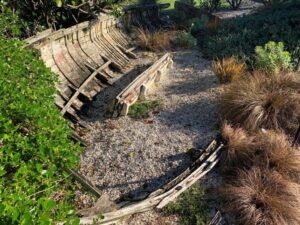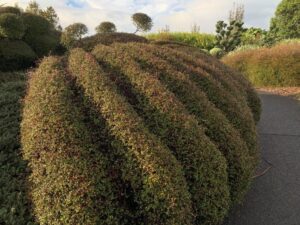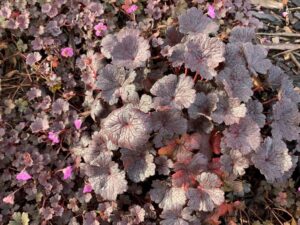
Showcasing New Zealand indigenous plants in creative ways
By Barbara Wheeler
Often seen growing as scrappy carpark plants, badly pruned to keep within the bounds of narrow strips of garden beds and frequently planted in the wrong place, the wonderful indigenous flora of New Zealand has had a history of being overlooked and much maligned in its own country. Thankfully, appreciation has grown over time with New Zealand species and cultivars now being planted in public gardens, city plantings and home gardens. But it’s not just planting New Zealand plants in public spaces, like botanic gardens, that makes a difference. Displaying plants in creative ways captures the attention of our garden visitors and inspires them to have a crack in their home garden or in their business.
Much of this stemmed from seeing them all around us in their natural setting, but also from how they were displayed in the public setting. At Auckland Botanic Gardens indigenous plants are displayed in many ways, but one garden collection shows a range of creative uses that can easily be transposed to the landscape sector and the home garden, or to serve as fodder for inspiring ideas.
The Native Plant Ideas Garden is a relatively small group of gardens that showcases a courtyard garden, an expression of a coastal and a subtropical garden, hedges and shrub borders. Throughout the collection strong foliage colours, textures and habits dominate, and are combined to whet our visitor’s appetites as to what can be achieved using indigenous plants.

There are several prominent features within the garden. The sculpture “Splayed” by Regan Gentry takes ubiquitous garden spades, puts them on steroids and creates a magnificent sculpture reminiscent of a large flower. Arguably though, it’s the plants that steal the show with a truly impressive planting using just two plants located in the centre of the collection. A grove of the Chatham Islands form of Rhopalostylis sapida (Nikau palm) stands tall on an elevated mound, and surrounding it, clipped as topiary, is Muehlenbeckia astonii (Mingimingi). Mingimingi is a robust plant suited to almost any situation. It is one of New Zealand’s fascinating divaricating plants, with a zig zag branching habit and the tiny heart shaped leaves, jewel-like flowers and fruit held amongst the tangle of branches. A curiosity of a plant, but one which is versatile whether it’s being clipped or left to grow naturally.
Clipping is utilised to display other plants in creative ways. Totara, Podocarpus totara ‘Albany Gold’ is clipped into large spheres that display the more formal garden look that can be achieved, while three Podocarpus totara ‘Matapouri Blue’ are slowly being cloud pruned to display how an indigenous plant can be used to create quite a different look in the landscape.

In other areas, it’s the minutiae that come to the fore. A wonderful plant that caught my eye is Geranium ‘Purple Passion’. It is an example of how the modest use of just one single plant en masse can create strong, engaging and impactful displays. The use of plants for foliage colour allows for a lot of creativity when playing with combinations. This is used extensively throughout the gardens. The many coprosmas and pittosporums available on the market, with more released each year, provides a constant supply of new varieties to try. Renovating plantings that are getting old and tired, or just in need of a refresh is constant in this collection and allows for the collection curator in charge to put their creative mark on the garden.
The use of an old boat, falling apart, and shell mulch helps ground the coastal garden so that the habitat is obvious. Pockets of colour erupt when the horokaka, NZ ice plant, is in flower, otherwise it is foliage form, colour and texture that prevails.
Seeing visitors in the Native Plant Ideas Garden engaging in the space, and being inspired by the range of plants and the creative ways that they are displayed, we hope they will grow an interest in plants and gardens which they can use in their landscape design or their home gardens. Even if it is just using one plant in a container, we hope to have hooked our visitors on using our indigenous plants and growing in them their own inspiring and creative ways.
Barbara Wheeler
Curator, Auckland Botanic Gardens,
Te Kaunihera o Tāmaki Makaurau / Auckland Council
E: Barbara.Wheeler@aucklandcouncil.govt.nz
